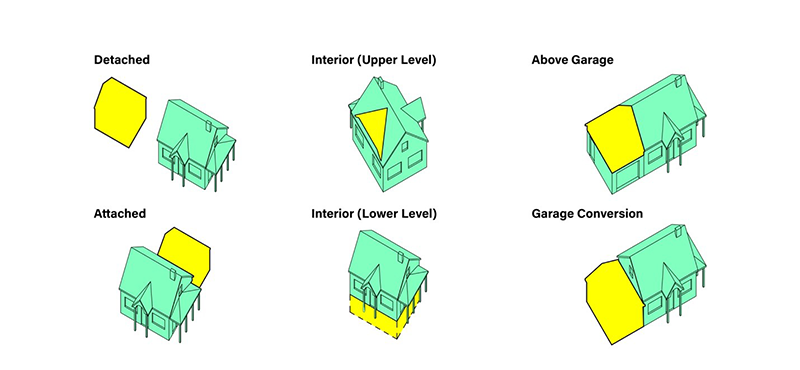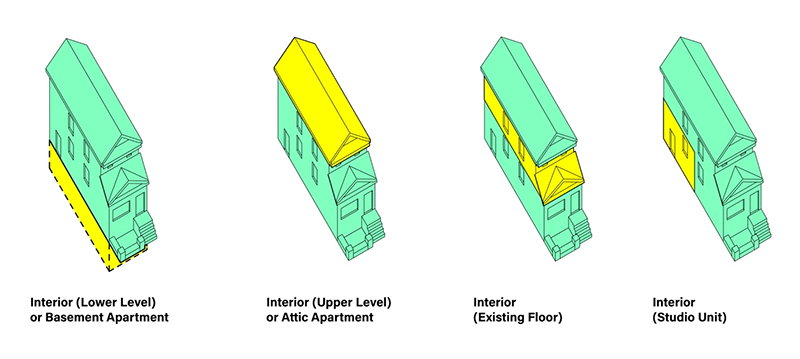How Nonprofits Are Using Accessory Dwelling Units as an Affordable Housing Strategy
Accessory dwelling units, or ADUs, have been proposed as a way to add housing stock to address the country’s housing crisis. ADUs are independent living spaces, outfitted with their own kitchen, bathroom, and sleeping area, and located on the same lot as a primary dwelling, but are smaller in size.
In rural and suburban neighborhoods, ADUs can be detached, attached, or interior units (Figure 1) and have been found to help older adults age in place, provide homeowners with additional income, and house caregivers and relatives on the same property as those who require their care.
FIGURE 1: ADUs come in many shapes, styles, and sizes
Given the economic and social benefits of ADUs, nonprofit housing organizations have begun supporting the expansion of this alternative type of housing. In “Nonprofit Accessory Dwelling Unit (ADU) Programs as Affordable Housing Strategies,” a new paper co-published by the Center and NeighborWorks America, I present research I did as a Gramlich Fellow on how nonprofit housing organizations are engaging with ADUs. Through site visits and interviews with practitioners, I identified four case studies and sought to answer three questions:
- How are nonprofit organizations using ADUs to provide affordable housing?
ADUs are used to fulfill a diverse set of housing needs and different programs demonstrate the varied services nonprofits provide related to ADUs:
- ADUs are helping older adults age in place and stay connected to their communities. Working with NeighborWorks Northeastern Pennsylvania, the Elder Cottage Housing Opportunity (ECHO) in Scranton, Pennsylvania provides older adults the opportunity to rent ADUs located on the properties of adult children or caregivers.
- Nonprofits are advocating for the formalization of interior ADUs in cities. The Basement Apartments Safe for Everyone (BASE) Campaign is a New York City-based initiative that advocates for the formalization of underground apartments, some of which are considered interior ADUs and could increase the supply of affordable housing options in the city (Figure 2). Similarly, the Landlord Repair Fund, launched by Asian Americans for Equality (AAFE), a community development organization in New York City, helps landlords repair and bring existing, non-compliant ADUs up to code. This case study demonstrates how community-based organizations are addressing safety concerns stemming from informal ADUs through broader renovation programs.
- Nonprofits are providing funding for ADU construction and renovation to low- and moderate-income homeowners. The Plus One ADU Program works with homeowners through partnerships with local governments and nonprofit organizations across New York state. It administers funding to community-based organizations that work on various stages of ADU development, including building new ADUs and upgrading existing ones.
FIGURE 2: Interior ADUs are often found in higher-density areas
- How are ADUs being adapted to serve different needs and populations?
There were several innovations developed through these ADU initiatives, to serve varying needs:
- The ECHO Program reduces barriers for older adults to reside in ADUs by simplifying the development, permitting, and construction processes. The program operates under a unique ownership model where a local Area Agency on Aging owns the units, which are then rented out. The nonprofit housing organization acts as the property manager once the unit is placed.
- The BASE Campaign identified avenues for residents of informal housing to receive financial and social support. It launched a pilot program for renovating basement and cellar apartments which revealed that there are zoning and financial considerations to address for these units to be safe to inhabit.
- The BASE Campaign, AAFE, and the Plus One ADU program are bringing greater awareness to safety concerns that are prompting homeowners and housing organizations to modernize ADUs, including better preparing them for climate-related challenges like flooding.
- What challenges are organizations facing in rolling out these initiatives?
There were three key challenges shared across the programs:
- The rules and regulations governing ADU construction differ widely across the country, which can create barriers to entry for community development organizations and homeowners interested in creating ADUs.
- Financing options for ADUs vary, especially based on their use, and require nonprofit organizations to think creatively about how to secure external funding via local and state government grants and private funds, like those from banks. Since there are a diversity of ADU project types, construction and development budgets also vary.
- ADUs can be politically contentious, especially when they are used in neighborhoods where zoning codes make it challenging to convert single-family homes into multifamily dwellings. Another challenge is building public support for urban ADUs in cities where they are not permitted. This is due, in part, to concerns about over-densification and the costs of renovations. Nonprofit organizations have created pamphlets, organized events, participated in political rallies, and conducted outreach to help educate people about the benefits of ADUs and to describe how informal ADUs can become safe to inhabit through renovations.
These programs demonstrate how nonprofit housing organizations are using ADUs to expand and support affordable housing options, particularly for smaller households, older adults, and cash-strapped homeowners. Their work demonstrates the viability of ADUs in both suburban and urban neighborhoods, which can be helped by further advocacy and dedicated funding for ADUs at the city, state, and federal level.



